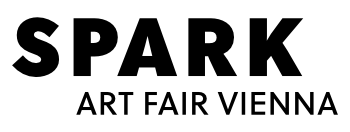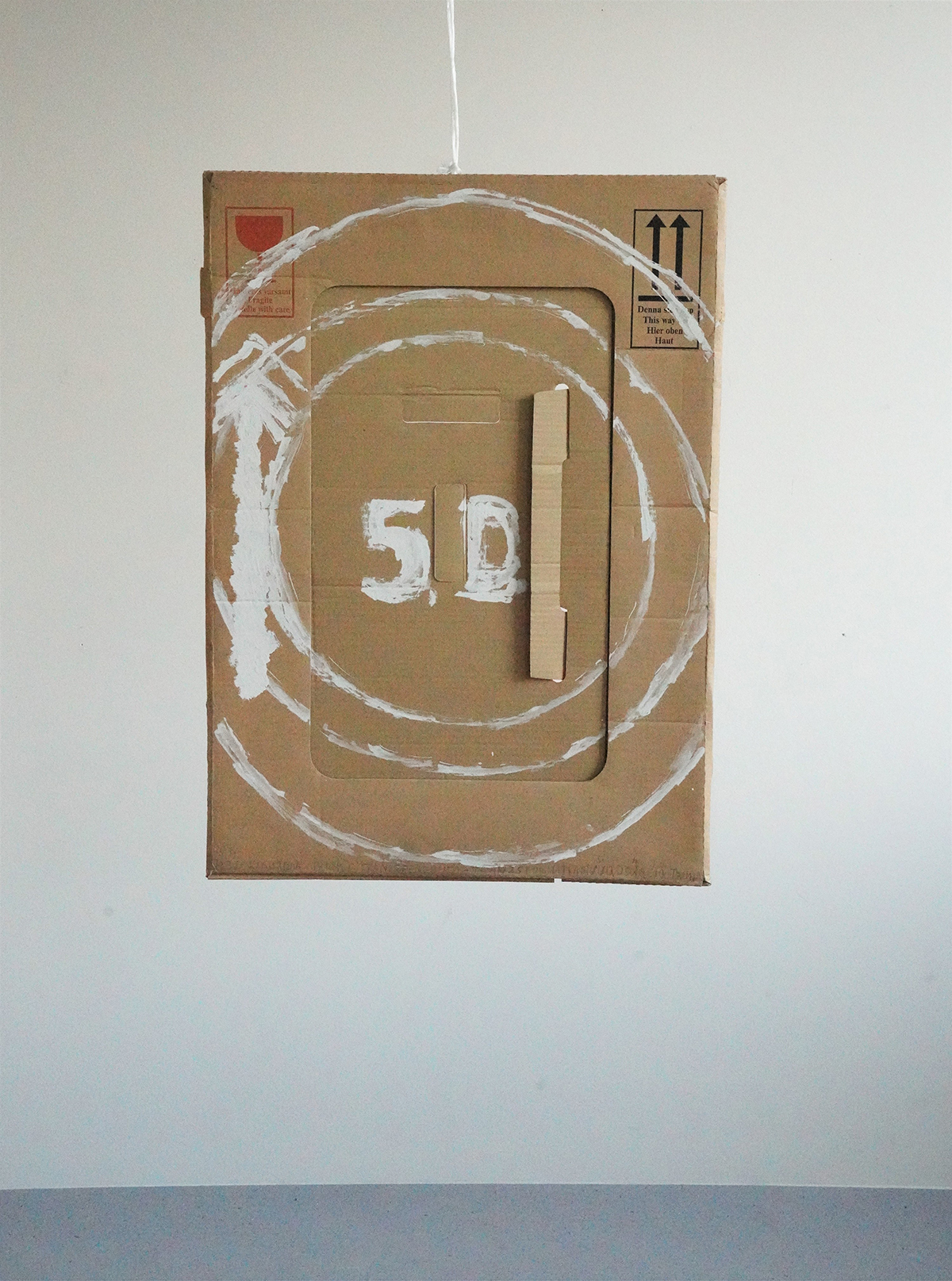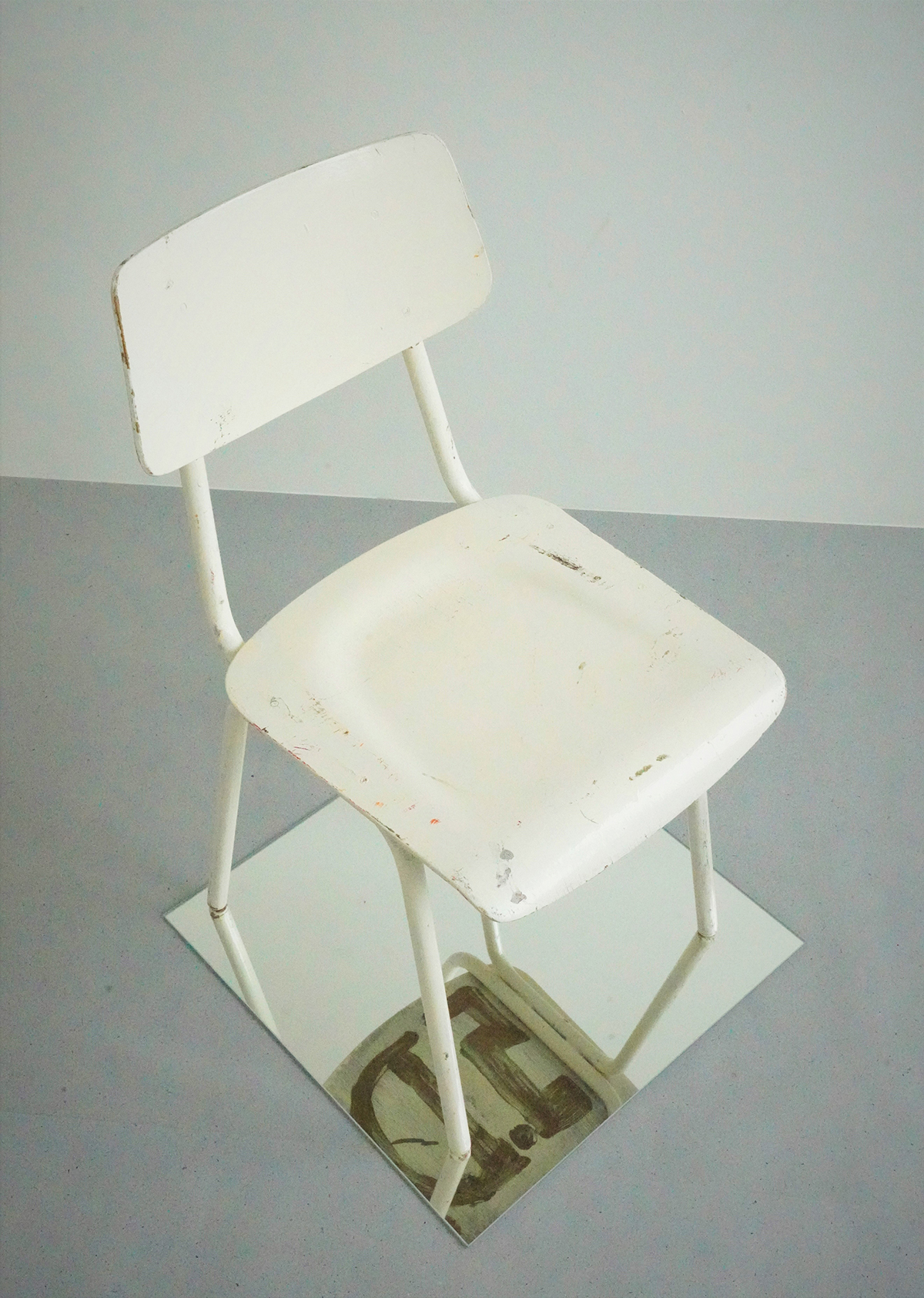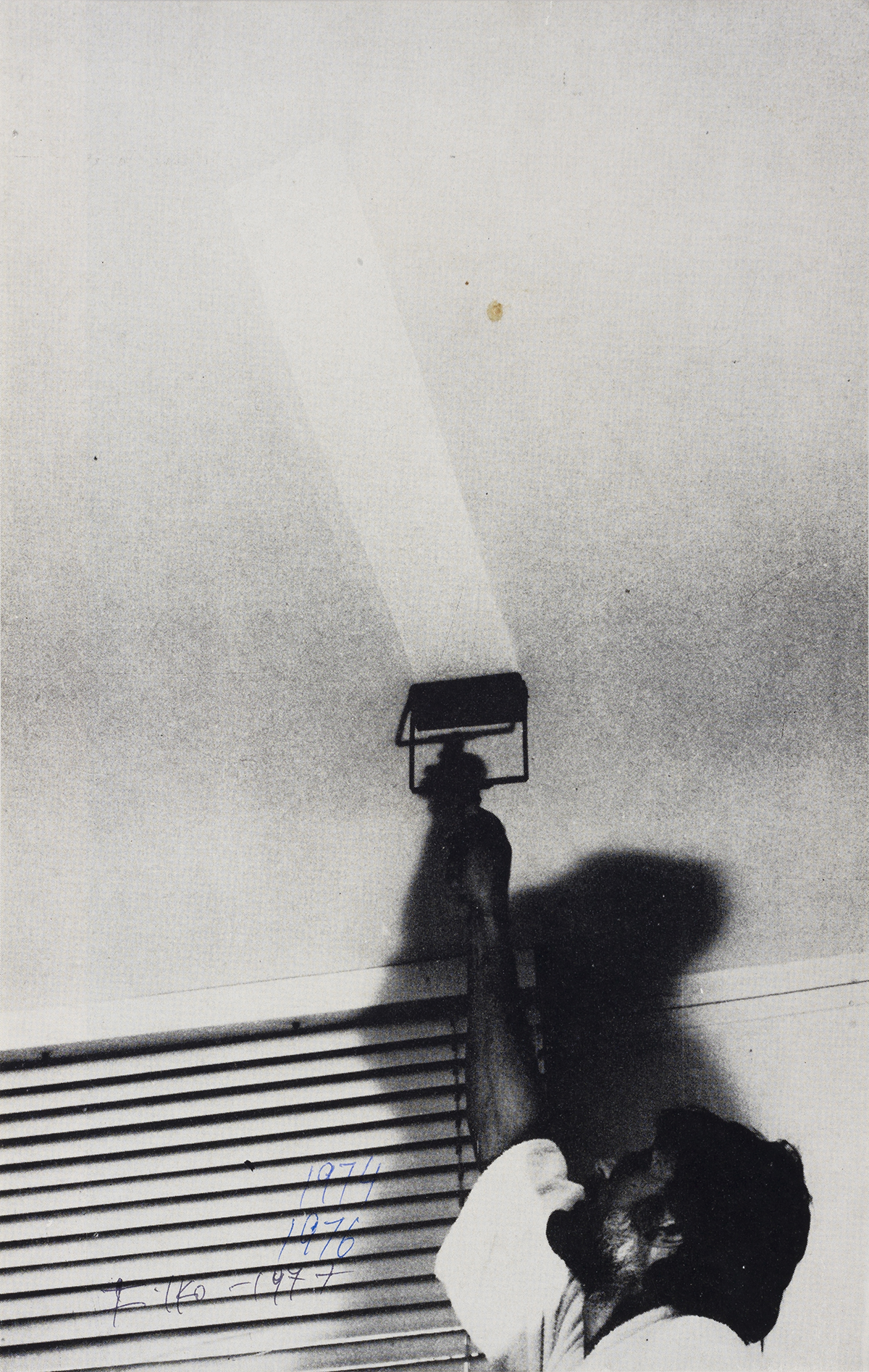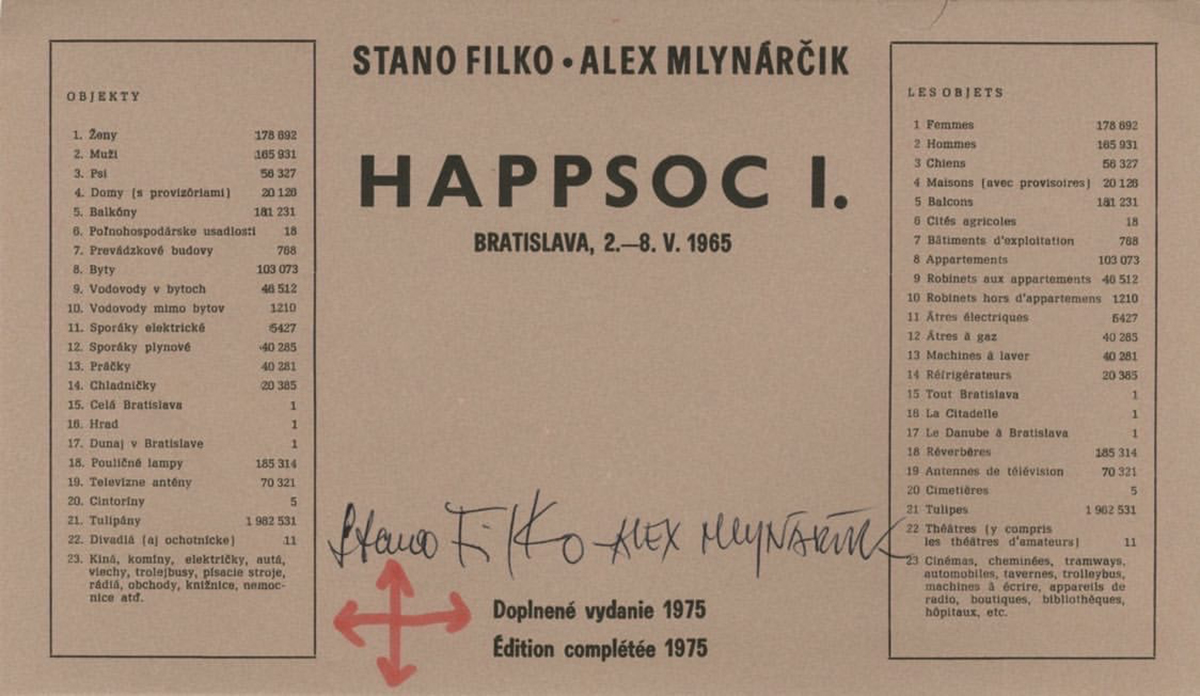LAYR
Stano Filko
The late Stano Filko belongs to the founders of conceptual art in Slovakia as one of the most fundamental artists involved in the anti-establishment art scene of the 60s and 70s throughout the period of political suppression.
His conceptual practice, consisting of (anti)happenings, ambient, installations, land art multiples, text art projects, objects and all kinds of diagram drawings, escapes any comprehensive understanding of his wide-ranging oeuvre. His two clinical deaths are also fundamental for his artwork, as a kind of catalyst for his inventiveness, which was emerging along with his exploration in and influences of philosophy, cosmology, religion and technological advancement.
While many works that he made in Slovakia at the time of heavy censorship bring about questions about the cultural, social but also private conditions, they are frequently profoundly immersed in the concept of cosmic exploration, today’s internationally prevalent transhumanist ideas, as well as in German Georg Wilhelm Friedrich Hegel’s and Moravian Edmund Husserl’s theories of phenomenology, foremost the phenomena of Transcendence, as well as other metaphysical principles.
Filko created his system of 5 dimensions and 12 chakras, individually uniformly treated as a colour of spectrum: RED as the biological sphere, GREEN as the socio-political space, WHITE as the ontological space, BLUE as the cosmic space, or INDIGO/BLACK as space of subject. This system is also the main code for understanding his works. This exhibition draws on works from 1968-2015 to deeper explore the chakras’; Transparent, White and Gold.
This white colour or hollowness signifies the white dimension, a stage on a path to Transcendence, to the “pure, nonphysical, eternal, and absolute art”.
Biography
Stano Filko (*1937 in Velka Hradna, Czechoslovakia – 2015 Bratislava, Slovak Republic) has been a key figure of the Slovakian Neo-Avantgarde. His entire oeuvre is based on an all- encompassing cosmology, which he began developing in the 1960s referring to references from philosophy and science to art and cultural history. After his participation at documenta 7 (1982) in Kassel, Germany, he immigrated to the USA and only returned to his hometown Bratislava in 1989. In 2005, Filko participated at the exhibition Model of the world/ Quadrophony in the pavilion of the Czech Republic and Slovakia in the 51. Venice Biennale, Italy.
Public collections include the Museum of Modern Art New York (USA), Tate Modern London (UK), Kunstmuseum Basel (CH), Guggenheim Collection (USA), Slovak National Gallery (SK), LINEA Collection Bratislava (SK), Folkwang Museum (D), Kröller-Müller Museum (N), Generali Foundation (A), , Kontakt. Art Collection (A), Kunstmuseum Liechtenstein (LIE), Pomeranz Collection (A) as well as the National Gallery Prague (CZ).
LAYR
LAYR was founded by Emanuel Layr in Vienna, Austria in 2011 in order to continue and enhance the agenda of his former gallery LayrWuestenhagen (2005-2011). The gallery program focusses on contextualizing and confronting notions and artistic manifestations of the conceptual with the relevant social, political and cultural issues of today. Based in a city with a long history of oscillation between hemispheres—East and West, North and South—, the program strives for interplay between artists from different generations and cultural or discursive backgrounds. The gallery is the exclusive representative of the estate of the late Slovak neo-avantgardist Stano Filko, as well as of Belgian-American artist Cécile B. Evans. Further evidence of the gallery’s precise and multi-layered focus can be found in its fruitful and ongoing collaborations with artists like Anna-Sophie Berger, Julien Bismuth, Andy Boot, Plamen Dejanoff, Gaylen Gerber, Lena Henke, Benjamin Hirte, Lisa Holzer, Dominique Knowles, Birgit Megerle, Lili Reynaud-Dewar and Philipp Timischl.

019451791
Clara Pohl
067764511358
Stano Filko
The late Stano Filko belongs to the founders of conceptual art in Slovakia as one of the most fundamental artists involved in the anti-establishment art scene of the 60s and 70s throughout the period of political suppression.
His conceptual practice, consisting of (anti)happenings, ambient, installations, land art multiples, text art projects, objects and all kinds of diagram drawings, escapes any comprehensive understanding of his wide-ranging oeuvre. His two clinical deaths are also fundamental for his artwork, as a kind of catalyst for his inventiveness, which was emerging along with his exploration in and influences of philosophy, cosmology, religion and technological advancement.
While many works that he made in Slovakia at the time of heavy censorship bring about questions about the cultural, social but also private conditions, they are frequently profoundly immersed in the concept of cosmic exploration, today’s internationally prevalent transhumanist ideas, as well as in German Georg Wilhelm Friedrich Hegel’s and Moravian Edmund Husserl’s theories of phenomenology, foremost the phenomena of Transcendence, as well as other metaphysical principles.
Filko created his system of 5 dimensions and 12 chakras, individually uniformly treated as a colour of spectrum: RED as the biological sphere, GREEN as the socio-political space, WHITE as the ontological space, BLUE as the cosmic space, or INDIGO/BLACK as space of subject. This system is also the main code for understanding his works. This exhibition draws on works from 1968-2015 to deeper explore the chakras’; Transparent, White and Gold.
This white colour or hollowness signifies the white dimension, a stage on a path to Transcendence, to the “pure, nonphysical, eternal, and absolute art”.
Biography
Stano Filko (*1937 in Velka Hradna, Czechoslovakia – 2015 Bratislava, Slovak Republic) has been a key figure of the Slovakian Neo-Avantgarde. His entire oeuvre is based on an all- encompassing cosmology, which he began developing in the 1960s referring to references from philosophy and science to art and cultural history. After his participation at documenta 7 (1982) in Kassel, Germany, he immigrated to the USA and only returned to his hometown Bratislava in 1989. In 2005, Filko participated at the exhibition Model of the world/ Quadrophony in the pavilion of the Czech Republic and Slovakia in the 51. Venice Biennale, Italy.
Public collections include the Museum of Modern Art New York (USA), Tate Modern London (UK), Kunstmuseum Basel (CH), Guggenheim Collection (USA), Slovak National Gallery (SK), LINEA Collection Bratislava (SK), Folkwang Museum (D), Kröller-Müller Museum (N), Generali Foundation (A), , Kontakt. Art Collection (A), Kunstmuseum Liechtenstein (LIE), Pomeranz Collection (A) as well as the National Gallery Prague (CZ).
LAYR
LAYR was founded by Emanuel Layr in Vienna, Austria in 2011 in order to continue and enhance the agenda of his former gallery LayrWuestenhagen (2005-2011). The gallery program focusses on contextualizing and confronting notions and artistic manifestations of the conceptual with the relevant social, political and cultural issues of today. Based in a city with a long history of oscillation between hemispheres—East and West, North and South—, the program strives for interplay between artists from different generations and cultural or discursive backgrounds. The gallery is the exclusive representative of the estate of the late Slovak neo-avantgardist Stano Filko, as well as of Belgian-American artist Cécile B. Evans. Further evidence of the gallery’s precise and multi-layered focus can be found in its fruitful and ongoing collaborations with artists like Anna-Sophie Berger, Julien Bismuth, Andy Boot, Plamen Dejanoff, Gaylen Gerber, Lena Henke, Benjamin Hirte, Lisa Holzer, Dominique Knowles, Birgit Megerle, Lili Reynaud-Dewar and Philipp Timischl.
